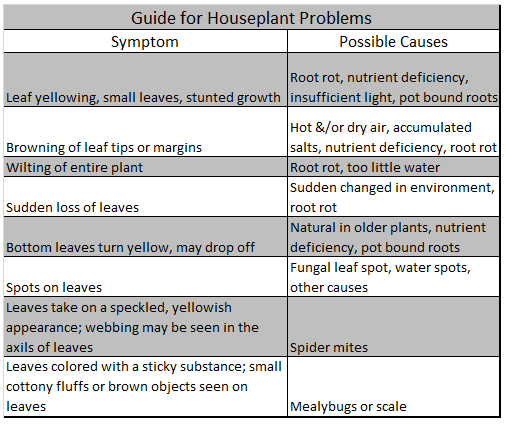Root Rot: Several contributing factors include:
- Overwatering
- Heavy soils (too much clay)
- Containers that lack adequate drainage holes.
Solution:
- Always water thoroughly until water comes out the drainage holes. Do not water again until just below the surface of the soil is barely moist.
- Use a quality potting soil which will adequately allow for drainage
- Assure that containers have drainage holes
If root rot is suspected, remove plant from the container and visually inspect the roots. Healthy roots will appear fibrous with white root tips. The presence of rot will have roots that have blackened tips and slimy brown-black decay. If root rot is not extensive, try to improve drainage by employing the solutions above.
Nutrient Deficiency: There are several nutrient deficiencies possible:
- Nitrogen deficiency is displayed by leaves that turn pale green or yellow
- Potassium deficiency is displayed in brown and dying of leaf margins.
- Phosphorus deficiency is a little harder to define. Some symptoms could include the leaves turning a dark, dull green or bluish green.
Solution: If nutrient deficiency is suspected, fertilize appropriately. Always read and follow the instructions on the fertilizer bottle.
Hot &/or Dry Air: This problem is most severe in the winter months where a lack of humidity and high heat are issues.
Solution: If heat and humidity are a concern, keep plants away from heat ducts, vents or radiators. Increase humidity by placing container is a shallow bed of water covered pebbles, being careful that the plant does not sit in the water. Placing the plant in a room where a humidifier is available.
Insufficient Light: Symptoms include pale, yellow, small leaves and poor growth.
Solution: If insufficient light is suspected, determine the proper light intensity for the plant and place it in an appropriate location.
Accumulated Salts: A noticeable white or yellow crust on the soil surface and plant stems is a good indication of accumulated salts. Plants that have been established in a pot for a length of time may accumulate this from fertilizers or hard water.
Solution: At least once a month, apply enough water to the top of the soil to thoroughly leach all excess salts to the bottom of the pot. A loose porous soil helps with this leaching process as well.
Pot Bound Roots: Pots that have been growing in the same pot for extended periods of time can become pot bound. An easy indicator is to lift the plant out of the container and note roots circling around the potting soil.
Solution: Repot the new plant using a pot that is 1-2 inches wider and deeper than the previous pot.
Sudden Change in Environment: Sudden leaf drop is a good indicator that a plant’s environment has changed. Environmental changes that can cause this include: rapid temperature change, drafts or dry, hot or cold air, change of location from sunny to dark.
Solution: Understand your plant’s environmental needs and follow them.
Fungal Leaf Spot: Minute black dots on the leaves are an indicator of this fungus.
Solution: Keep the foliage dry, and pick off and destroy infected leaves if infection is minimal. Keep this plant isolated from all other plants.
Water Spots: Some plants, such as African violets, are susceptible to water spots when leaves get splashed with cold water. Aerosol sprays, sun shining on wet leaves, hot grease spattering can also irritate some plant leaves.
Solution: Take caution not to get water on the leaves. Also avoid other spattering sources.
Mites and Insect Problems: Bronzed colored leaves and webbing can be noticed on plants infected with spider mites. Also, placing a white sheet of paper under a leaf and tapping the plant can identify spider mite damage. The mites will fall onto the sheet of paper and will resemble very tiny dots.
Solution: Preventative measures are important by using the identifiers listed above. Spider mites are attracted to plants under stress. Keeping plants healthy will help to solve this. Also a steady stream of water applied to your plant every 2 weeks can help rid the problem. Insecticidal soaps are also effective at eliminating spider mites.
In general, be careful to consider the plant’s best location, surroundings, water requirements and history. These can also give you good indicators as to what your plant is experiencing.
Source: Purdue University Cooperative Extension



